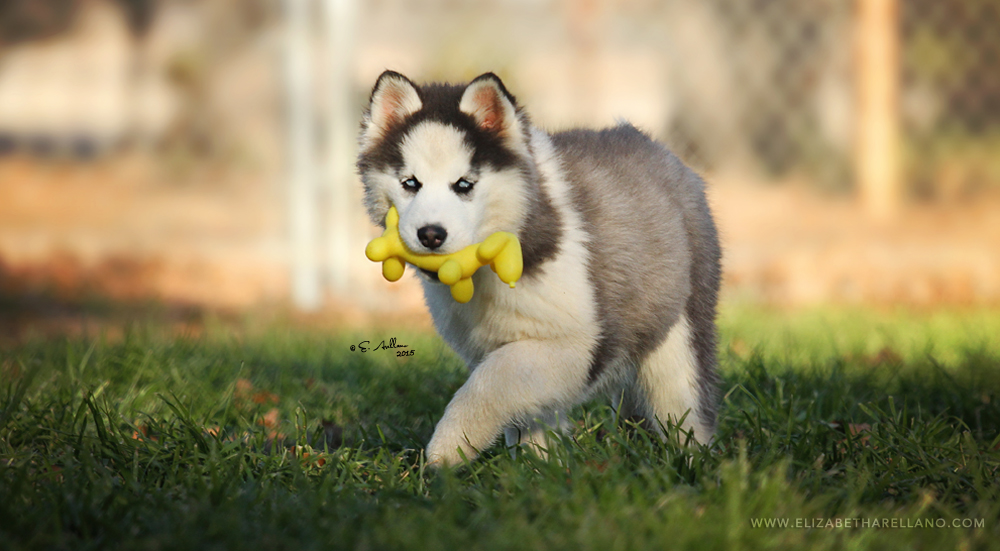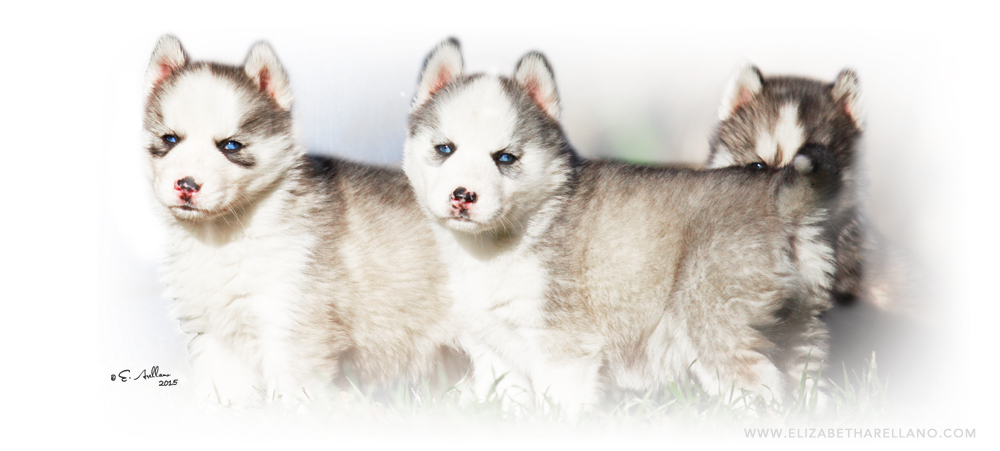About Your Husky
ORIGIN
The breed was developed by the Chukchi people of Northern Siberia, and introduced in to this country in the early 1900's.
During the winter of 1925 a Diphtheria epidemic raged through to town of Nome Alaska. The people were saved from certain death when teams of Siberian Huskies carried the life saving serum from distant Nenana to Nome. Of all the drivers, Leonard Seppala and Gunner Kasson traveled the farthest, through the worst trail conditions. The Iditarod Trail Sled Dog Race commemorates this famous delivery. Today a monument statue of "BALTO" one of the lead dogs stands in Central Park, New York City to commemorate the event.
TEMPERAMENT
The characteristic temperament of the Siberian Husky is friendly and gentle, but also alert and outgoing. He does not display the possessive qualities of the guard dog, nor is he overly suspicious of strangers or aggressive with other dogs. Some measure of reserve and dignity may be expected in the mature dog. His intelligence, tractability, and eager disposition make him an agreeable companion and willing worker. Huskies are friendly dogs that were bred to live in large groups. The Siberian willingly obeys simple commands from an owner he respects, but training involves patience and a good understanding of the Husky character.
SIZE
Height: Dogs, 21 to 23 1/2 inches at the withers. Bitches, 20 to 22 inches at the withers.
Weight: Dogs, 45 to 60 pounds. Bitches, 35 to 50 pounds.
COAT & GROOMING
The Siberian Husky standard allows all colors from black to pure white are allowed. A variety of markings on the head is common, including many striking patterns not found in other breeds. Our Huskies are typically Black & White, Red & White, Grey, and Grey & White although other colors are allowed and acceptable. While eye color can be brown or blue in color; one of each or parti-colored are acceptable, Troika Huskies typically have blue eyes.
The Siberian Husky is a very clean dog by nature and free of the "Doggie Odor" that many breeds have. His coat is thick and dense with longer guard coat covering and protecting the undercoat. It is a coat that can withstand the harshest of winter temperatures. This heavy coat makes your dog look stunning most of the year, however, your Husky will shed his undercoat twice a year, typically during the late spring and summer and fall. During the big sheds, you should be prepared to brush and comb out lots and lots of hair. A good bath with warm water will help to speed the process.
TRAINING
The Siberian willingly obeys simple commands from an owner he respects, but training involves patience and a good understanding of the Husky character. This however is a byproduct of the work you put into your puppy that will allow them to develop to their full potential. We advocate that you take your puppy to Socialization Classes and Obedience Training Classes starting at an early age. This training is best when it teaches you how to train your dog. Huskies can learn to be obedient but it does take effort on the on the part of the new owner. Your puppy can be very head strong and have his own idea about how things work and it is up to YOU to guide him in the right direction. The best training for a Husky is FIRM but FAIR and consistent. Early training will help your puppy bond to his new family and make him a well behaved companion for years to come. You will be rewarded many times over from the time you spend training your puppy during the first year of his life.
PREDATOR BY CHOICE
While the Siberian Husky is normally gentle and friendly with people and other dogs, THE PREDATORY INSTINTS ARE STRONG IN THIS BREED. TROIKA puppies have been raised around CATS and know how to behave. The new owners must continue this relationship and also be aware that small animals such as Squirrels, Rabbits, Hamsters, Guinea Pigs, Birds, and CATS are potential victims of their strong predatory instincts. Huskies are swift, cunning, patient and deadly, in their hunting skills.
CHEWING AND DIGGING
All puppies chew and dig but the Siberian Husky can take these things to a higher level. We recommend that NYLABONES and GUMABONES be kept in abundance as well as large fist size RAWHIDE bones. Another good cheap toy is the gallon jug that your milk comes in. The dogs like to carry them around by the handle and bump them into things. Huskies love to dig. It is a passion with them. If you are the kind of person that wants their yard to look like "Better Homes and Gardens" then you need to set aside an area that the puppy can call his own and let him go to work. There is nothing finer than to lie in a freshly dug hole in the cool earth and watch the world go by.
ACTIVITY
Siberian Huskies have been described as escape artists, which can include digging under, chew through, or even jumping over fences especially when left alone for long periods thinking up all sorts of unacceptable activities according to his owner. Therefore, Huskies MUST HAVE A SECURE FENCED YARD OR BE KEPT ON A LEASH. The Siberian was bred for centuries to move man and his belongings from place to place and never look back. Because Huskies were bred to be a sled dog, they tend to RUN. He is an active dog with an active mind and will not do well in a "Couch Potato" type family. They need the frequent companionship of people and other dogs, and their need to feel a part of a pack is very strong.
SWIMMING POOLS
Siberian Huskies love water. If you have a home with a swimming pool, you need to show your puppy where the steps are and allow him to swim over to them, and learn how to get out of the pool several times. This will safely teach them how to enjoy the swimming pool without the danger of drowning.
SPAY OR NEUTER
As a responsible breeder we do suggest that you have your dog either spayed or neutered. Breeding dogs is a serious business and should not be undertaken by people that do not have a vast knowledge of the breed and a working knowledge of genetics and the hereditary defects in all breeds of purebred dogs. Female dogs do not have to have a litter of puppies before being spayed. That is an old wives tale. Having puppies even under the best of conditions can lead to serious physical problems or the death of your beloved pet. Neutered animals live longer and healthier lives. Spaying or neutering your Siberian Husky will NOT turn it into a fat lazy couch potato. TOO MANY TREATS AND NOT ENOUGH EXERCISE DO THAT.
OWNERSHIP RESPONSIBILITIES
When you bring your pupy home, you will expect to keep them forever, we know that. Sometimes, however, unexpected life changes happen such as divorce, death in the family, loss of job or moving, you may be forced to make the hard decision to give up your dog. Please NEVER take your Troika Siberian Husky to an animal shelter - you should contact the breeder of your dog first. As breeders, we want to stay in touch with the people that buy our dogs and are concerned about their welfare for the life of the dog. Animal Shelters are a death sentence for most of the dogs and cats that end up there, and we don't want to see that happen to any dog that we have bred. Don't turn your dog loose in the country either. Contact us first - for whatever reason - so we can take responsibility for one of our puppies.
IN CLOSING
We want to be as much help as we can to the new owner of "OUR DOG". Please contact us with any question or concern that you may have. We either know the answer or know someone that does. We want the ownership of a TROIKA SIBERIAN to be a happy and pleasant experience that will last for the lifetime of your dog.
|


